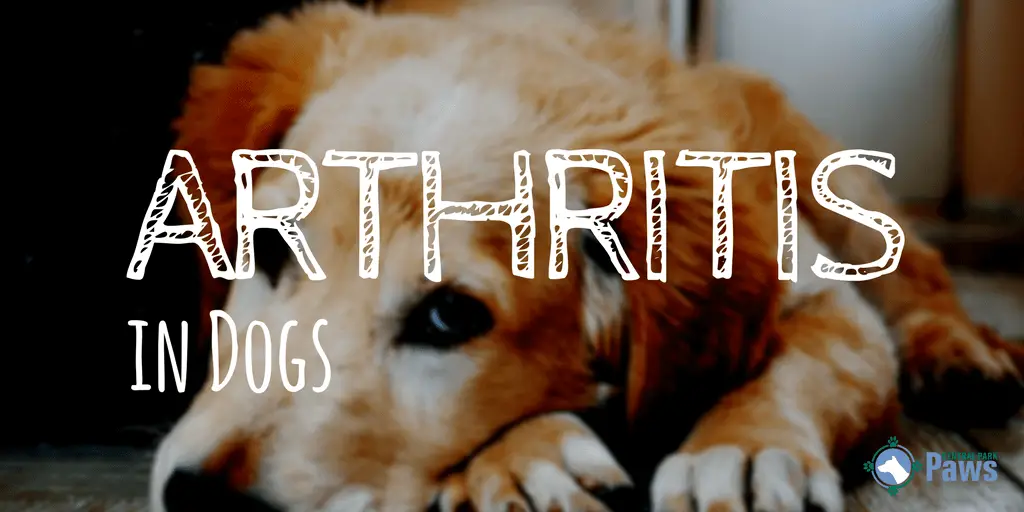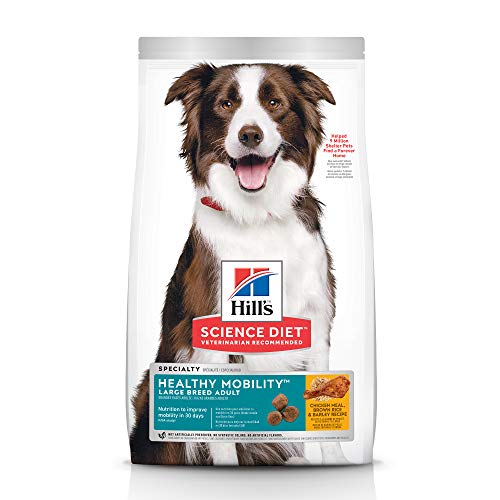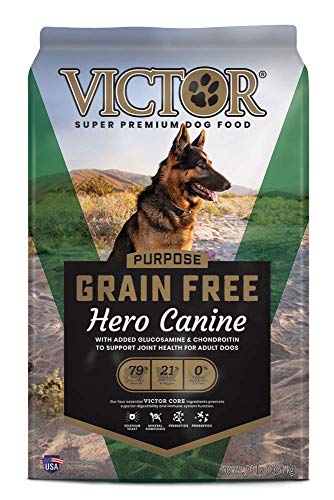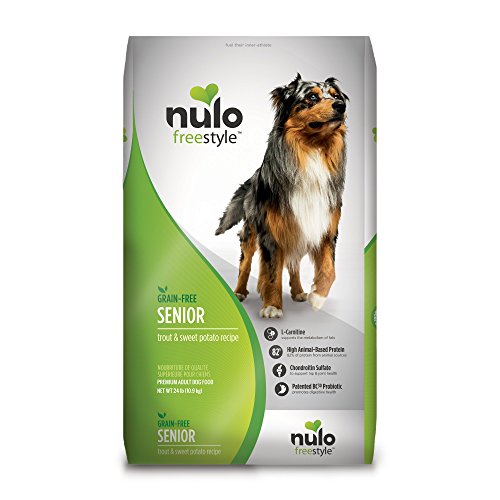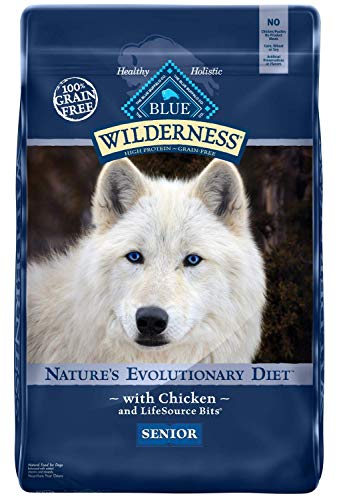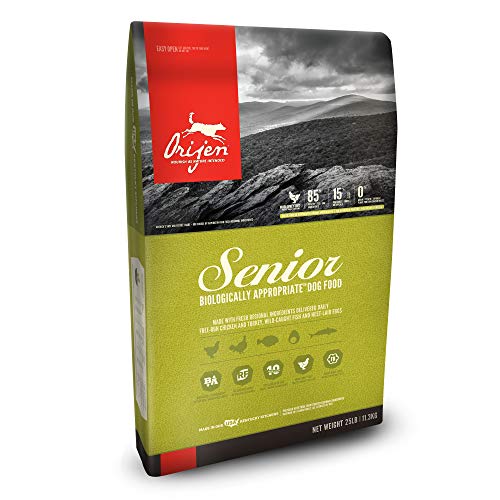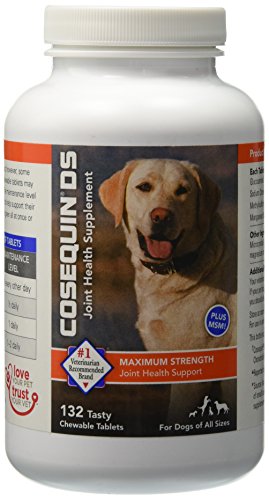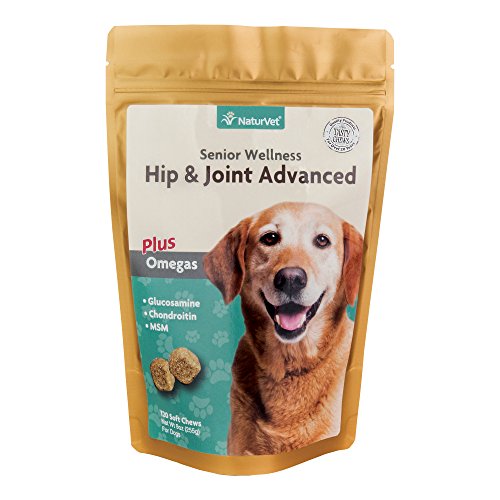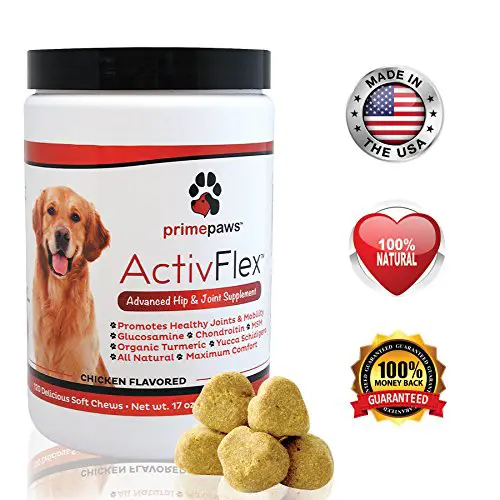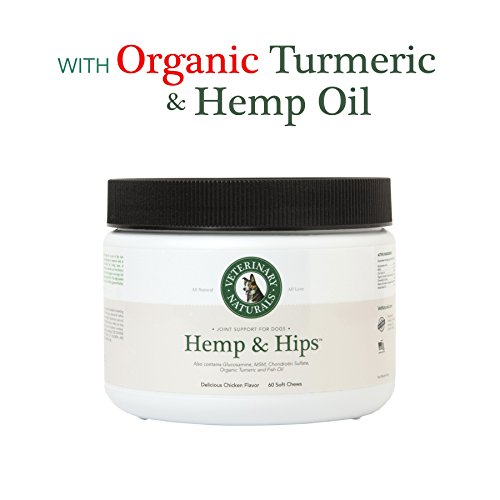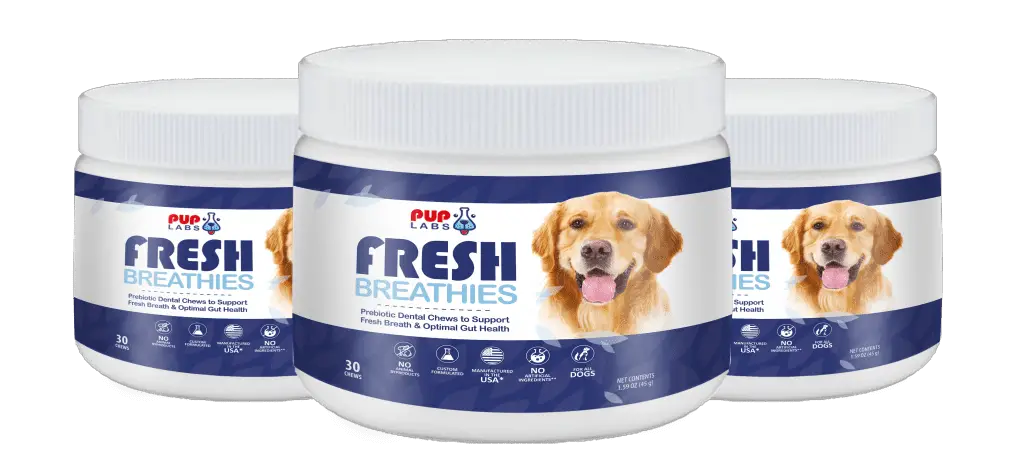It was so subtle, we actually missed it.
It’s not that we didn’t notice – we did – but it was just easy to rationalize away…
It’s cold, he doesn’t want to leave the warm spot in front of the fire.
He was up late barking at that stupid cat, he’s just tired.
He doesn’t need to go out again, he just went.
It’s hot out, he’s just being lazy – I don’t want to go out in this heat, either.
But it started to add up, and after a trip to the vet, we had our diagnosis; our beloved Choco had canine arthritis.
What Canine Arthritis Is
Similar to humans, canine osteoarthritis is inflammation and degeneration of the joint and surrounding tissue.
It generally starts as erosion of the cartilage of the joint, and while there could be numerous other root causes, the end result is the generic term “arthritis” as a diagnosis.
As a rule, arthritis is progressive and degenerative – and usually irreversible.
And it’s not relegated just to older dogs. It’s an equal opportunity disease.
That being said, keep in mind there are two types: primary and secondary arthritis.
Primary is just what you think it would be – there’s nothing else going on but the arthritis.
Arthritis as a secondary diagnosis means there is some other primary issue, and that the arthritis is either in addition to, or a result of, that problem.
Both are treatable.

The main types of arthritis are:
Inflammatory (Rheumatoid) Arthritis
This type of arthritis causes the immune system to go on the fritz and start attacking the joints. Not nice.
Infectious (Septic) Arthritis
Like its name suggests, this type is caused by an infectious agent, such as bacteria or virus.
Although the infection can be treated, and damage done may likely be permanent.
Metabolic Arthritis
The formation, or excess, of uric acid at the cellular level results in a crystalline formation causing joint pain. This is also known as Gout.
It is treatable and controllable, just like in humans.
Although advanced cases of arthritis damage are irreversible, the treatment options still offer an increased quality of life – and if caught early enough can add years of active play for both of you.
What Canine Arthritis Isn’t
When there is joint pain in our four legged companions, it is often instinctive to assume it’s a natural process of age – which it certainly can be.
But all too often, the uninformed self-diagnosis of “arthritis” is given to other ailments – and doing so may cause not only increased and unnecessary pain and joint damage, but the wrong diagnosis may interfere with other treatment options.
It’s important to remember that arthritis is oftentimes an end-result diagnosis that stems from another primary diagnosis – which treatment. Some other joint diseases include:
Dysplasia
Affecting the hip and elbow, dysplasia is basically a malformation of the joint. Although genetically driven, nutrition and exercise can be factors in the severity of dysplasia.
There are several treatment options for the various stages of dysplasia, but a quick and accurate diagnosis is imperative.
Dietary
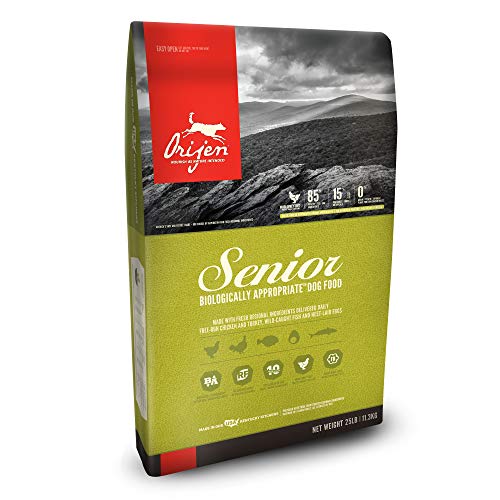
While diet can unquestionably contribute to arthritis, a poor diet that leads to obese malnutrition (think the equivalent to you eating fast food every day), or an overly rich diet, can lead to their own issues – but sometimes it just comes down to the dog limping because it’s too fat.
And that we can correct!
Lyme Disease
In the past years, instances of Lyme disease transmission have been on the rise – but so has our defense. We protect ourselves and our children, both 2- and 4-legged, with the best mixture of chemicals legally available for sale.
But infection does happen, and in its early stages it is most noticed by the lameness and swelling of joints – and this added to the lethargy can be confused for arthritis, especially if your furball is on a flea and tick prevention.
Injury
A torn ligament or a hairline fracture can be overlooked until we see our canine companion favoring a leg. Left untreated, this easily correctable condition can lead to permanent – and irreversible – damage.
Cancer
We hate to include this, but it is a fact of life – as much as we love them and do the best to give them a life filled with play and treats and snuggles, the cruelty of life rears its ugly head. An early diagnosis leads to a better outcome.
What Causes Arthritis in Dogs?
The causes of arthritis are wide and varying. It can be a result or side effect of other joint disease, genetic disposition, or simply from old age.
Apart from these obvious origins, there are several other subtle causes that, if left unchecked, can result in arthritis as well as other diseases.
The good news is that several of these are completely controllable, and some instances you can stop the damage before it gets to the point of interfering with the quality of life – or requiring treatment!

Age
Just like anything else – from our cars to our parents, the older it gets the more prone it is to breakdowns.
It’s inevitable, and the price we willingly pay for the unconditional love we receive and give.
Poor Weight Management
Yeah – you knew this was coming! We are absolutely NOT going to start down the slippery road discussing which senior dog food is better than another, or if this ingredient causes cancer, or any of the other conspiracy theories.
Suffice it to say a fat dog is an unhealthy dog – and needs to go on a diet!
Exercise
I joke with a friend of mine about going to the gym; they say it won’t kill me and I reply that I’m not willing to take the chance.
But the truth is that over-exercising our dogs is a serious matter, especially if they are prone to dysplasia or have suffered an injury.
Having a puppy enrolled in agility training before their joints have fully formed can result in an early-onset joint disease and arthritis.
It’s also advisable to consider the terrain – walking or running only on concrete or pavement will quickly take its toll on hips, shoulders, and elbows.
Injury
Some injuries are avoidable. Letting your dog ride in the bed of a pick-up truck while driving through a neighborhood full of squirrels is just asking for trouble.
Puppy bowling by throwing toys down the hallway after waxing the floor for the dogs to chase and slide … Well, my bad.
Dog Arthritis Symptoms
There are two levels of symptoms; those we see and those we don’t.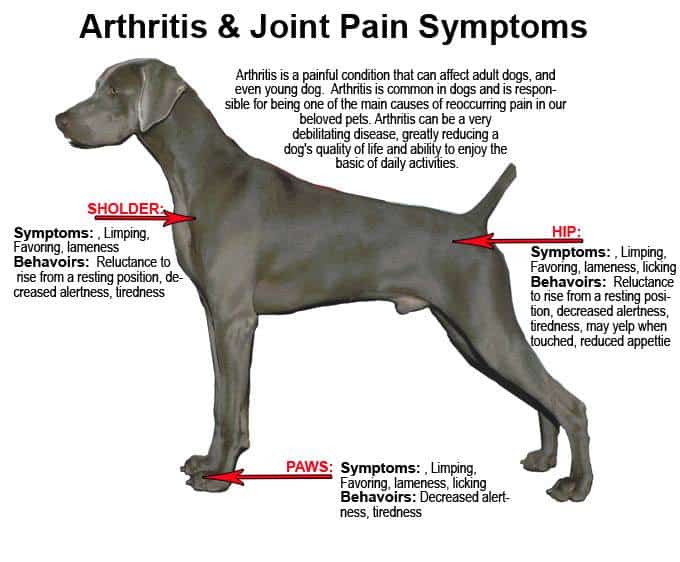
Symptoms We See
The observable signs of arthritis are straightforward, albeit somewhat vague at times;
- Stiffness
- Limping
- Slow to get up
- Restlessness
- Inability – or refusal – to get up on the bed or couch
- Wincing or crying from pain
Symptoms We Don’t See
The symptoms we don’t see are – such as the actual joint damage, or the wearing away of cartilage – are only observable through x-ray. Sometimes, palpation by a vet in just the right spot can reveal inflammation while it is still asymptomatic.
Because the symptoms can be so vague, and especially if our pup refuses to slow down, treatment can be delayed.
It bears mentioning that sometimes we all get an ache for a day or two from working or playing too hard, and our dogs are no different.
Running to your vet for every little thing can quickly result in the average household going broke – but a thorough examination every year can make a huge difference.
You can also make a difference by starting to familiarize yourself with Fluffy’s bedtime habits and keep an eye out for any changes that last more than a few days.
Dog Arthritis Treatments
If you’re received the diagnosis of arthritis, don’t panic.
Seriously. It’s not the end of the world, and it’s absolutely not a death sentence.
Knowledge is power, and now time is on your side.
Depending on the extent of the damage, there are numerous options available.
And although there’s no way to regenerate the lost cartilage, there are options that can improve joint lubrication and reduce inflammation – and those are important for quality of life.
There are also surgical options, which should be discussed with your veterinarian, or referred to a specialist.
It is also important to mention that unless the primary cause for the arthritis (if the arthritis is a secondary diagnosis) is addressed, then the deterioration will continue.
Once the cause is stopped, the joint damage will stop – and arthritis can be held at bay.
Lifestyle Changes
Probably some of the simplest changes that can make a large impact are modifications to the daily routine.
They can be done is small increments so as to not throw the household into an uproar – and can easily be tracked and tweaked.
Physical Aids
There are many little things you can do that will add up to big helps, without spending a fortune or undertaking a massive construction project.
Consider one or more of the following, depending on the size of your dog and their physical needs:
- Ramps or stairs can help your dog get where he needs to without jumping up or down. Especially useful for smaller dogs to be able to get onto your bed or couch, if Fluffy is used to snuggling up with you, this can help enable that while making it easier.
And just like puppy love makes us feel better – they need lovin’ from us as well.
- Raised bowls make eating and drinking easier for the larger breeds, but arthritic dogs can do better with an elevated feeding and watering station as well.
- Harnesses are not for all breeds (like, uh, huskies – unless you want to be drug down the block) but if your pooch has arthritis in his neck or front end, these are definitely preferred over regular collars.
- Knee braces for dogs sounds odd but go down to your local park and you’ll see middle aged men jogging around with at least one on. The same reasoning goes for your dog. The less pressure put on their joints, the less pain they’ll have.
- Consider clothing. Yes, I know – I’m the one who swore my dogs would never be seen wearing a fru-fru sweater in public, but the truth is that for an arthritic dog, sweaters, coats, booties, and socks can have a dramatic impact, especially in cold weather.
Just think of how Aunt Ida’s arthritis acts up when it’s cold out. And our canines can’t complain like she can. Come to think of it, no one can complain like she can…
Diet Change
Yes, there it is. The “D” word that makes us all cringe and hide our Kit Kats. But we all have to face dietary changes in our lives for various reasons, and Bruiser is the same.
In humans, losing one pound of weight converts to FOUR pounds of pressure on your knees. While there is no exact formula to convert it over to canines, it’s still obvious that eliminating excess weight can have a huge impact on joints.
Some things to consider;
- Check the nutritional content per cup fed. As you reduce the amount per feeding in an effort to reduce excess weight, it’s important that you are not sacrificing protein, vitamins, and minerals. One cup of Brand A may not equal the nutritional content of one cup of Brand B.
One of my dogs is on a specialized diet because it’s all I can do to get that 80 lb GSD to eat two cups of food – even with mixing in chicken or beef.
A different popular brand required FIVE cups of food to equal the same nutritional content – so if she only ate 2 cups she would quickly become malnourished.
Bottom line: read the label.
- When changing brands of foods, be sure to do it gradually, over 5-7 days to eliminate any tummy trouble. No one wants a dog with tummy trouble!
- Consider the add-ins to increase the protein and other vitamins or minerals. Meat (cooked or raw – I don’t judge) or fresh veggies can go a long way to fill the belly and stimulate the taste buds.
- Eliminate the table scraps. Seriously – stop them. Table scraps not only add more of fat, salt, and sugar than your canine needs – they also teach bad habits of begging.
Essential Oils
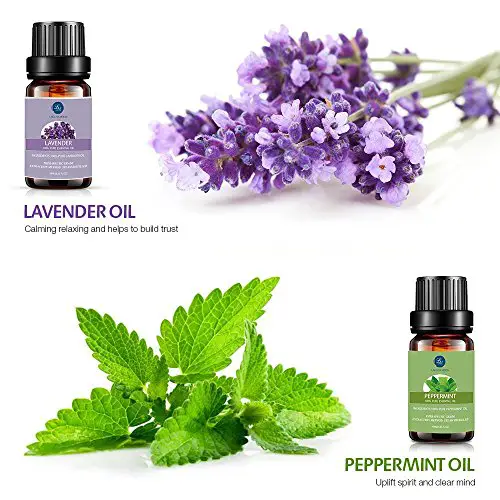
While you should take many of these claims with a grain of salt, there is quite a bit of evidence that many essential oils can be effective at easing your pooch’s discomfort.
If you’re interested in learning more about using essential oils for pain relief and anti-inflammation on your arthritic dog, we wrote a whole article on it here.
Exercise

Okay, so this one’s tricky, because exercise can be what got your pup in this predicament to start with.
Too much or the wrong type of exercise can compound the pain and damage while better choices can ease the pain and build muscle – which can in turn aid in support.
- Walking should be done on soft surfaces only. A short car ride to the park should be chosen over a walk around the block. Avoid pavement or concrete walking as much as humanly possible.
- Like with humans, water therapy can do wonders. Most community pools do not allow dogs, but with a little help from Google you should be able to locate a pond or lake that will do nicely.
- Slower is better – but don’t completely eliminate running and playing. Try rolling balls along the ground to eliminate jumping into the air, and definitely try to avoid any agility training type of obstacles.
Orthopedic Dog Bed
It’s amazing what a difference a good night’s sleep can have on our outlook on life. It’s the same for our canines. A well-researched orthopedic dog bed is absolutely worth the negligible investment.
For a review of the most popular brands, check out our review of the best orthopedic dog beds.
Keep in mind that more expensive is not necessarily better – but above all you need to choose the best quality your budget will allow.
Sleeping without pain and being able to get upright easily will make an incredible difference in the quality of life – and a better quality of life can translate into a longer life.
Best Dog Foods for Arthritis
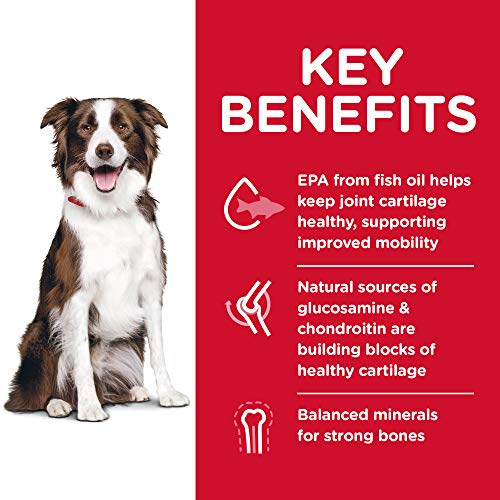
Look for dog foods with glucosamine, Chondroitin, and/or Methylsulfonylmethane supplements.
Fish oil supports healthy cartilage and keeps it from deteriorating.
Whether you add this supplement in to your dog’s diet via food or supplement, fish oil and its Omega-3 can shave 10 dog-years off your aging mutt.
Grains can also cause inflammation in some dogs so a grain free option might be a good choice.
Foods high in protein can help build or maintain muscle, which takes stress off the joints as well.
Also, make sure to pay attention to the recommended serving size. You may need to reduce it if weight is an issue for your pup.
Vet Recommended Dog Food for Joint Health
Hill’s Science Healthy Mobility for Joint Health
Key Features:
Contains Glucosamine, Chondroitin, and fish oil
- Made with natural ingredients
- Vet recommended
- Made in the USA
Overall Impression: Vet recommendations hold a lot of weight when it comes to choosing the right dog food among the sea of options. And Hill’s Healthy Mobility dry food is the #1 vet recommended dog food (as of 2017).
Not only that, Hill’s has the joint supplements that your dog needs, has added minerals for overall health, and is made in the USA.
It’s a solid dog food to start your arthritic dog on to see how much changing their diet can help.
Best Dog Food for Younger Dogs with Joint Issues
VICTOR Purpose Grain Free Hero Canine
- Contains glucosamine And chondroitin
- Contains prebiotics and probiotics
- Made for adult breeds susceptible to joint issues
- High in protein
- Grain free
Overall Impression: The Victor Hero Canine dry food is ideal for breeds that have a higher chance of developing arthritis later in life.
You know how they say an ounce of prevention is worth a pound of cure? This is a perfect example.
By giving them the supplements they need to maintain healthy joints and cartilage while they’re still in their prime, you might be able to prevent them from ever having joint issues in the future.
Besides the glucosamine and Chondroitin, this dog food is an excellent choice for most dog owners. The first 3 ingredients of this “super premium dog food” are beef meal, sweet potato, and chicken fat.
That’s what you want to see out of a dog food. Lots of protein and healthy fiber with plenty of vitamins can keep your furry friend operating at peak performance.
You might say it can turn them into a… Hero Canine.
Best Grain Free Dog Food for Arthritis
Nulo Senior Grain Free Dog Food
- Contains glucosamine and chondroitin
- Contains probiotics
- Grain free
- 80% protein
Overall Impression: If Hill’s Healthy Mobility wasn’t “science-y” for you, don’t worry, Nulo has you covered. They’ve done the research to keep this dry dog food as close to their “ancestral diet”.
It’s basically the paleo diet of dog food if you bought paleo-friendly food in a 24 pound bag.
What makes this grain free food better than most is the added minerals, vitamins, probiotics, and supplements formulated specifically for older dogs.
Lastly, some dogs have bad reactions to eggs and chicken protein. Fortunately, Nulo’s Senior food comes in a trout and sweet potato flavor.
Best Complete Senior Dog Food for Joint Health
Blue Buffalo Wilderness Natural Senior Dry Dog Food
Key Features:
- High in protein
- Grain free
- Proprietary blend of antioxidants, vitamins, and minerals
- Improves much more than just joints
Overall Impression: I’ll be honest, I have no idea what “Lifesource Bits” are but this Blue Buffalo food has ’em. Whoever was in charge of naming must have been sick that day.
Apparently these “bits” are “a precise blend of antioxidants, vitamins and minerals carefully selected by holistic veterinarians and animal nutritionists to support immune system health, life stage requirements, and a healthy oxidative balance.”
What makes Blue Buffalo’s Senior dog food special is that it doesn’t just focus on joint health. Their formula is designed to help improve heart health, immune systems, muscles, teeth, and energy levels.
If you’re looking for a dry food for your older dog who might have more health concerns than just joints, this is an excellent option.
Honorable Mention for Grain Free Complete Senior Dog Food
ORIJEN Senior Dry Dog Food
- Enhanced with fatty acids, chondroitin, and glucosamine
- Grain free
- 85% meat inclusions; 15% vegetables and botanicals
- Ingredients are fresh and locally sourced
- Made in the USA
Overall Impression: Let’s go ahead and get this out of the way. Orijen is not the cheapest brand.
It’s probably because they source fresh ingredients from nearby farmers in Kentucky. And making everything in-house in their DogStar Kitchen can’t be the cheapest way to produce dog food.
But you do get a very high quality product for that price tag. This grain free food is made with fresh, raw ingredients like free-run chicken and turkey, wild-caught flounder, cage-free eggs, Atlantic mackerel, and Atlantic herring.
Unfortunately, as great as the ingredients are, Orijen’s Senior dog food didn’t make the top spot on our list due to its premium price.
Dog Arthritis Medications
There are a number of over the counter medicines available from your local pet store, your vet, or trusted online retailer that do not require a prescription.
Your veterinarian can recommend which would be the best for your pup based on several factors, including ingredient, dosage, and side effects.
NEVER give your dog human medicine without consulting your veterinarian. Not the internet – an actual real, live veterinarian.
Caveat: Do not purchase any products that are regulated by prescription, from a source that will sell them without said prescription.
Ingredients and dosage is extremely important, and only a less than reputable business would circumvent this process – and as a general rule they do it with inferior or expired medications.
Joint Supplements for Dogs
Most joint supplements are either Glucosamine, Chondroitin, or a mixture of both.
While they do not regenerate cartilage, there does seem to be improvement of symptoms with continued use of these products, most likely due to the increased lubrication and decreased inflammation.
Since they aren’t harmful, it certainly doesn’t hurt to try.
Nutramax Cosequin DS PLUS MSM
Active ingredients (per 1 tablet):
- 600mg Glucosamine
- 300mg Chondroitin Sulfate
- 250mg Methylsulfonylmethane (MSM)
Overall Impression: The initial period and maintenance dosage instructions are straightforward and easy to understand.
The pills, although somewhat large, are scored for easy snapping in half.
Nutramax is a well known brand name, and the product is made in the USA.
NaturVet Senior Wellness Hip & Joint Advanced Plus Omegas
Active Ingredients (per 2 soft chews):
- 250mg Glucosamine
- 50mg Chondroitin Sulfate
- 250mg Methylsulfonylmethane (MSM)
- 100mg Omega-3
- 25mg Omega-6
Overall Impression: The dosage seems to be a little bit more, shall we say, ‘open to interpretation’, but with the lower amounts of active ingredients it’s not surprising.
This option’s formula is marketed for senior dogs, a more inclusive formula, and is wheat free. Made in the USA in an FDA audited facility.
Prime Paws ActivFlex
Active Ingredients (per 2 soft chews):
- 625mg Glucosamine
- 210mg Chondroitin Sulfate
- 325mg Methylsulfonylmethane (MSM)
- 500mg Turmeric
- 235mg Vitamin C
Overall Impression: The addition of turmeric (a natural anti-inflammatory) aids in treating canines with stiff and sore joints by reducing the pain, which boosts their activity level.
The formula – made in the USA in an FDA inspected facility – is all natural and gluten free, with no corn, wheat, soy, or added sugar. The combination of ingredients is formulated to relieve joint pain and improve mobility.
As a give-back, for every bottle purchased, they donate 1 lb of food to a shelter. I like that.
Veterinary Naturals ‘Hemp & Hips’
Active Ingredients (per 1 soft chew):
- 450mg Glucosamine
- 50mg Chondroitin Sulfate
- 225mg Methylsulfonylmethane (MSM)
- 125mg Turmeric
- 10mgs Hemp oil
Overall Impression: This formula is based on the ‘healing properties’ of hemp. Don’t worry, your dog won’t be getting stoned or the munchies. The dosage is straightforward with no initial plus maintenance dosages.
Made in the USA at a FDA registered facility, for every bottle sold they will be vaccinating 3 street dogs in Nepal. Don’t ask – I don’t know why or how, either.
Doggie Dailies Glucosamine for Dogs
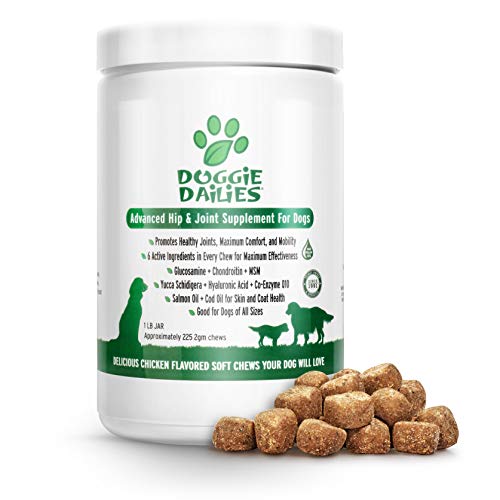
- 100mg Glucosamine
- 50mg Chondroitin Sulfate
- 100mg Methylsulfonylmethane (MSM)
- 50mg Yucca Schidigera
- 10mg Coenzyme Q10
- 10mg Hyaluronic Acid
Overall Impression: Sure, that ingredients list looks pretty good. But it gets better.
Not only do Doggie Dailies provide plenty of supplements for joints, it also includes Omega 3 & 6, Vitamin C & E, and Salmon Oil & Cod Liver Oil for skin and coat health.
And the chicken flavored chews are tasty enough that you could use them as treats. The bottom line is it won’t be hard to get your dog to take his “medicine”.
And if you’ve ever had trouble giving a dog a pill, you know how big of a deal that is.
Zesty Paws Pure Wild Alaskan Salmon Oil for Dogs
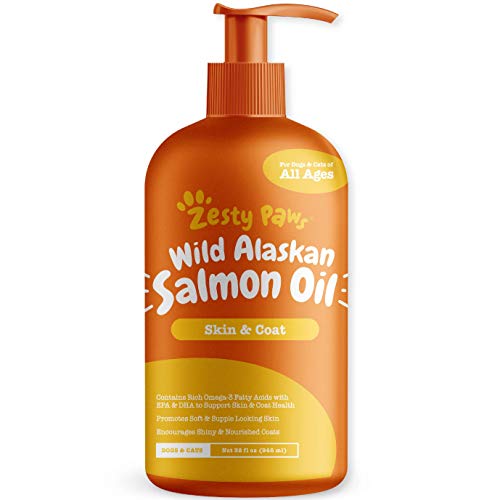
- 1,100mg Omega-3 fatty acids
- 390mg EPA
- 480mg DHA
Overall Impression: Not only does this supplement help with your pet’s joints, it reduces shedding, improves coat, promotes healthy skin, supports immune system, and increases heart health.
And the best part? Dogs actually enjoy the taste. A lot.
Zesty Paws’ salmon oil dog food supplement is a no-brainer for dog owners whose pooches have any skin, coat, heart, or joint issues. It’s easy to use and can make a world of difference.
Anti-Inflammatories for Dogs
I said it before and I’m saying it again; NEVER give human medication to dogs – even if you read on the internet what kind of dosage to give. Human medications have a different mixture of active and inert ingredients that can be deadly to your pooch.
The most common medications are NSAIDs – non-steroidal anti inflammatory drugs – and are available from your local pet store. For higher doses, or a stronger dose, see your vet for a prescription option.
Aspirin
The most popular OTC option due to its ability to reduce pain, aspirin should be given carefully because of its anti-coagulant properties – and never for extended periods of time.
Do try to purchase only the coated tablets to ease and potential stomach upset.
Ibuprofen
Not as readily available over the counter as aspirin, ibuprofen is another in the NSAID family that works as an anti-inflammatory. Should be taken with a bit of food.
Acetaminophen
While available, acetaminophen is not widely recommended due to the potential to damage the liver when taken for extended periods of time – and contrary to popular belief, it is not an NSAID.
There is a brand formula available by prescription.
Pain Relief
If you’re wondering what you can give your dog for pain, there are more than just pills as a treatment option for pain relief – and oftentimes they can be more effective by way of building muscle and increasing blood flow.
Pain relief also increases quality of life – and isn’t that what it’s all about?
Acupuncture
Like in humans, the core claim of acupuncture is to have the ability to reduce or even relieve chronic pain. It’s a highly debated topic, and a personal choice.

Massage
Who doesn’t find a massage soothing and relaxing?
With the result being that the tensed muscles relax and relaxed muscles ache less, and joints can relax as well.
Physical Therapy
The prime directive of physical therapy is range of motion. With range of motion comes building of muscle and loosening of ligaments – all will serve to benefit arthritic joints and increase mobility.
Natural Remedies for Dog Arthritis
We always want to try the natural remedies first. From grandmas concoctions for ‘whatever ails ya’ to the local organic food store, there’s a cultural shift away from laboratory produced chemicals to a product that comes right out of the earth, naturally.
Above all else, stay away from any manufacturer that refuses to list their ingredients.
There are many companies that claim to use small-farm harvested herbs, all-natural ingredients, or essential oils – but do not list what those “ingredients” even are.
For a brand to claim “proprietary formula” is all well and fine – but think twice before you give your beloved pet a smorgasbord of unknown chemicals because you’re starting a game of Russian roulette that’s too easy to lose.
Turmeric
Also called ‘Indian Saffron’, is a natural pain reliever, and is often a primary or secondary ingredient with Glucosamine or Chondroitin for its anti-inflammatory properties.
Some of the side effects of turmeric include constipation, kidney stones, and stomach upset. It is important that turmeric should never be taken simultaneously with aspirin.
And stay within the dosage when used as a stand-alone supplement.
Yucca
The Yucca plant itself is poisonous to dogs – it’s the root that boasts therapeutic properties for managing arthritis pain – but must be closely monitored and used in only small doses. More is NOT better.
Licorice Root
When monitored for quality and consumption, licorice root can be effective combating inflammation and pain.
The chemical compound glycyrrhizin is similar to the cortisone produced by the body, and supports the immune system.
But the same caution applies; too much or extended usage can lead to serious side effects.
Ginger
A wonderful, holistic root that’s bursting with benefits – for humans. Dogs, not so much.
While it does aid in gastric upset and muscle pain, it should only be given in controlled doses – and preferably under the direction of a veterinarian.
Alfalfa
Natural alfalfa is rich in nutrients, and effective in combating the pain of arthritis. When purchased through a pet store or an organic grower, the health benefits are plentiful.
But, as with any other herbal remedy, the devil is in the fine print. Improperly dried alfalfa can cause severe digestive issues, and unfiltered seeds are toxic.
Also, if the alfalfa is harvested post-bloom, it can trigger pollen allergies.
Cayenne
Derived from hot peppers, the potency comes from capsaicin and is supposed to block pain and increase circulation. I don’t know about you, but when I watch guys chewing on hot peppers to prove their virility – I sure don’t see pain relief.
Commercially, the cayenne is processed into cream or pills.
The major drawback with the use of cayenne for pain relief is the potential shortcut of grabbing the jar of cayenne pepper from the spice cabinet and sprinkling it onto Fido’s food.
That’s bad.
Like, really bad.
Will Your Dog Die From Arthritis?
Arthritis isn’t the end. It’s not a death sentence.
It’s a natural process of life, and oftentimes a result of injury.
And just like in us humans, your beloved dog will learn to live within his new limitations – and we will do what we can to make their life as healthy and happy as we can – like we have always done.
There are numerous treatment options available – medicinal as well as natural – and more than a few that are just plain common sense.
Starting with the lifestyle changes and then adding a joint supplement could be the first step towards a new life for your arthritic pooch.
As far as Choco – he’s still going strong at 11 years old. He has good days and not-so-good days, but the good says outweigh the bad. His quality of life is good, albeit a little slower.
Except when he is stealing a slice of pizza off the dining room table.

